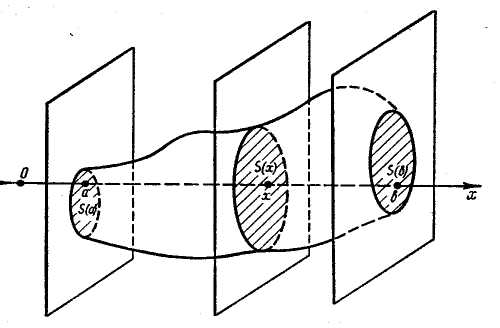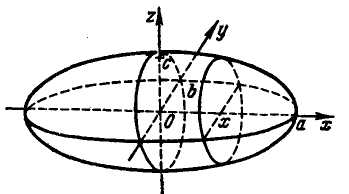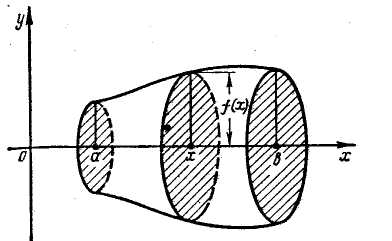
- •Міністерство освіти і науки україни донецький національний технічний університет
- •Integral calculus (інтеґральне числення)
- •Донецьк 2005
- •Integral calculus lecture no. 19. Primitive and indefinite integral
- •Point 1. Primitive
- •Properties of primitives
- •Point 2. Indefinite integral and its properties
- •Point 3. Integration by substitution (change of variable)
- •Point 4. Integration by parts
- •Lecture no.20. Classes of integrable functions
- •Point 1. Rational functions (rational fractions)
- •Point 2. Trigonometric functions
- •Universal trigonometrical substitution
- •Other substitutions
- •Point 3. Irrational functions
- •Quadratic irrationalities. Trigonometric substitutions
- •Quadratic irrationalities (general case)
- •Indefinite integral: Basic Terminology
- •Lecture no. 21. Definite integral
- •Point 1. Problems leading to the concept ofa definite integral
- •Point 2. Definite integral
- •Point 3. Properties of a definite integral
- •I ntegration of inequalities
- •Point 4. Definite integral as a function of its upper variable limit
- •Point 5. Newton-leibniz formula
- •Point 6. Main methods of evaluation a definite integral Change of a variable (substitution method)
- •Integration by parts
- •Lecture no.22. Applications of definite integral
- •Point 1. Problem – solving schemes. Areas
- •Additional remarks about the areas of plane figures
- •Point 3. Volumes
- •Volume of a body with known areas of its parallel cross-sections
- •Volume of a body of rotation
- •Point 4. Economic applications
- •Lecture no. 23. Definite integral: additional questions
- •Point 1. Approximate integration
- •Rectangular Formulas
- •Trapezium Formula
- •Simpson’s formula (parabolic formula)
- •Point 2. Improper integrals
- •Improper integrals of the first kind
- •Improper integrals of the second kind
- •Convergence tests
- •Point 3. Euler г- function
- •Definite integral: Basic Terminology
- •Lecture no. 24. Double integral
- •Point 1. Double integral
- •Point 2. Evaluation of a double integral in cartesian coordinates
- •Point 3. Improper double integrals. Poisson formula
- •Point 4. Double integral in polar coordinates
- •Double integral: Basic Terminology
- •Contents
- •Integral calculus 3
- •Integral calculus (Інтеґральне числення): Методичний посібник по вивченню розділу курсу ”Математичний аналіз” для студентів ДонНту (англійською мовою)
Point 3. Volumes
Volume of a body with known areas of its parallel cross-sections

Let some body is situated between the planes
,
![]() ,
and for any
,
and for any
![]() the area
the area
![]() of its cross-se-ction by a plane perpendicular to Ox-axis
is known (see fig. 16). The volume of the body equals the integral
Fig. 16
of its cross-se-ction by a plane perpendicular to Ox-axis
is known (see fig. 16). The volume of the body equals the integral
Fig. 16
![]() .
( 22 )
.
( 22 )
■ An element
![]() of the volume is the volume of a right circular cylinder with the
base
and the altitude
of the volume is the volume of a right circular cylinder with the
base
and the altitude
![]() ,
,
![]() .
.
Adding all these elements we get the required volume represented by the formula (22).■
 Ex.
15. Find the volume of the triaxial ellipsoid
Ex.
15. Find the volume of the triaxial ellipsoid
![]() (fig. 17)
(fig. 17)
For any
![]() the plane section of the body per-
Fig. 17
pendicular to the Ox-axis
is ellipse with the semi-axes
the plane section of the body per-
Fig. 17
pendicular to the Ox-axis
is ellipse with the semi-axes
![]()
and the area
![]() .
.
Therefore the volume of the ellipsoid by the formula (22) equals
![]() .
.
Volume of a body of rotation
 A curvilinear trapezium
A curvilinear trapezium
![]() (see fig. 1) rotates about
-axis.
Prove that the volume of the corresponding body (body
of rotation, fig 18) equals the
definite integral
(see fig. 1) rotates about
-axis.
Prove that the volume of the corresponding body (body
of rotation, fig 18) equals the
definite integral
![]() .
( 23 )
.
( 23 )
■ For any
a cross-section of the body of ro-
Fig. 18
tation by a plane perpendicular to Ox-axis
is a circle of radius
(fig. 18). Therefore its area
![]() ,
and by the formula (22) the vo-lume of the body in question is given
by the formula (23).
,
and by the formula (22) the vo-lume of the body in question is given
by the formula (23).
Let the same curvilinear trapezium
(fig. 1) rotates about
![]() -axis
and
-axis
and
![]() or
or
![]() .
Prove that the volume of the corresponding body of rotation is
represented by the integral
.
Prove that the volume of the corresponding body of rotation is
represented by the integral
![]() .
( 24 )
.
( 24 )
Ex. 16. Let the arc of a sinusoid
![]() rotates about the Ox-,
Oy-axes.
Calculate the volumes of corresponding bodies of rotation.
rotates about the Ox-,
Oy-axes.
Calculate the volumes of corresponding bodies of rotation.
With the help of the formulas (23), (24) we get
![]() .
.

![]() .
.
A curvilinear trapezium
![]() (fig. 6) rotates about
-axis.
Prove that the volume of the corresponding body of rotation is
represented by the integral
(fig. 6) rotates about
-axis.
Prove that the volume of the corresponding body of rotation is
represented by the integral
![]() .
( 25 )
.
( 25 )
Ex. 17. An ellipse rotates about the Ox-, Oy-axes. Calculate the volumes of corresponding bodies of rotation.
From the equation of the ellipse
![]() ,
,
and by the formulas (24), (25) we have
![]() ;
;
![]() .
.
Point 4. Economic applications
Problem 1 (produced quantity). Let the labour
productivity of a some factory at a time moment t
equals
![]() .
It is known (see the formula (11) of the point 2 of prce-ding
lecture) that its produced quantity U
during the time interval [0, T]
equals
.
It is known (see the formula (11) of the point 2 of prce-ding
lecture) that its produced quantity U
during the time interval [0, T]
equals
![]() .
.
Ex. 18. Let the labour productivity of a factory
is
![]() .
Then its produced quantity
.
Then its produced quantity
 .
.
Problem 2 (costs of conservation of goods). Let
is the quantity of goods in the storage at a time moment t,
and a quantity h
represents the costs of conservation of unit of goods per unit of
time. Then the costs of conservation of goods during a time interval
![]() (or an element of the costs of conservation) equals
(or an element of the costs of conservation) equals
![]() .
.
Adding
all these elements from
![]() to
to
![]() we get the costs of conservation of goods during the time interval
we get the costs of conservation of goods during the time interval
![]() ,
that is
,
that is
![]() .
.
Let, for example, we study the case of uniform
consumption of all goods from
![]() at a time
to
at a time
to
![]() at a time
.
In this case the quantity of goods at a time mo-ment t
is
at a time
.
In this case the quantity of goods at a time mo-ment t
is
![]() ,
,
and the costs of conservation of goods equals
![]() .
.
